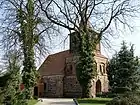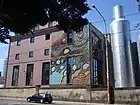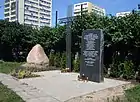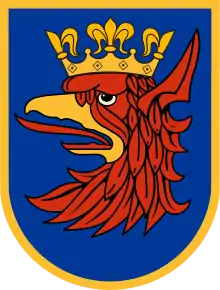Pomorzany | |
|---|---|
Municipal neighbourhood | |
.jpg.webp) Blocks of flats in Pomorzany | |
 Location of Pomorzany within Szczecin | |
| Coordinates: 53°23′58″N 14°31′34″E / 53.39944°N 14.52611°E | |
| Country | |
| Voivodeship | West Pomeranian |
| County/City | Szczecin |
| First mentioned | 1253 |
| Within city limits | 1864[lower-alpha 1]/1939[lower-alpha 2] |
| Population (2016[1]) | |
| • Total | 20,517 |
| Time zone | UTC+1 (CET) |
| • Summer (DST) | UTC+2 (CEST) |
| Area code | +48 91 |
| Car plates | ZS |
Pomorzany is a municipal neighbourhood of the city of Szczecin, Poland situated on the left bank of Oder river, south of the Szczecin Old Town. It borders Gumieńce to the west, Turzyn to the northwest, Nowe Miasto to the north, Międzyodrze-Wyspa Pucka to the east, and Gmina Kołbaskowo (Ustowo village) to the south. As of January 2011 it had a population of 21,957.[2]
History
The first traces of human activity in the area of today's Pomorzany date from the late Neolithic period. The stabilization of the settlement in this area occurred in the 8th century. The village (under the name of Pomerenstorp) was first mentioned in 1253 in document of Barnim I, Duke of Pomerania.[3] It was a suburb of Szczecin, which became the city's possession after 1319.[4]
The northern part of Pomorzany (German: Pommerensdorfer Anlagen) was incorporated into the city in 1864,[5] while the southern part in 1939, during the creation of Groß-Stettin (lit. Great City of Stettin), when neighbouring municipalities were amalgamated into Stettin.
During World War II, the Germans opened and operated seven forced labor camps in the district, for prisoners of various nationalities, including Poles, Yugoslavs and Russians.[6] Many prisoners died in the camps.[6] Allied air raids destroyed many residential buildings and factories.[7] Following Germany's defeat in the war, in 1945, the suburbs along with the city of Szczecin became again part of Poland.
The suburb was eventually incorporated into Szczecin on 5 July 1945.
In 2007, a monument to the victims of the local Nazi German forced labour camps from World War II was erected, unveiled by one of its survivors, Florian Nowacki.[6]
Economy
The Bosman brewery is located in Pomorzany.
Gallery
 Saint Maximilian Kolbe church
Saint Maximilian Kolbe church.jpg.webp) Saint Joseph church
Saint Joseph church Bosman Brewery
Bosman Brewery Monument to the victims of German forced labour camps from World War II
Monument to the victims of German forced labour camps from World War II
Notes
References
- ↑ "Statystyki demograficzne Bazy Ewidencji Ludności". Biuletyn Informacji Publicznej Urzędu Miasta Szczecin (in Polish). Archived from the original on 14 January 2016. Retrieved 4 June 2021.
- ↑ "Zestawienie informacyjne o liczbie osób zameldowanych w Szczecinie" (in Polish). Urząd Miasta Szczecin. Archived from the original on 2007-12-30. Retrieved 2011-01-14.
- ↑ Łuczak, Marek (2010). Szczecin Pomorzany. Szczecin: Pomorskie Towarzystwo Historyczne. p. 12. ISBN 978-83-7518-192-0.
- ↑ Srokowski, Stanisław (1947). Pomorze Zachodnie. Studium geograficzne, gospodarcze i społeczne (in Polish). Instytut Bałtycki. p. 129.
- ↑ Łuczak, Marek (2010). Szczecin Pomorzany. Szczecin: Pomorskie Towarzystwo Historyczne. p. 30. ISBN 978-83-7518-192-0.
- 1 2 3 Monika Stefanek. "Uczczono przymusowych robotników obozów pracy". Głos Szczeciński (in Polish). Retrieved 4 June 2021.
- ↑ Łuczak, Marek (2010). Szczecin Pomorzany. Szczecin: Pomorskie Towarzystwo Historyczne. p. 36. ISBN 978-83-7518-192-0.
